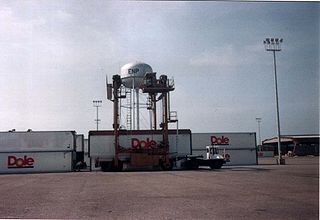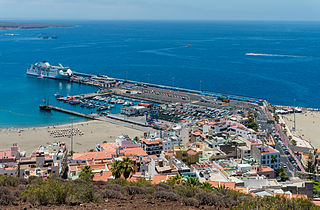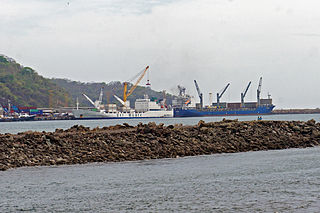Related Research Articles

Canada, the world's second-largest country in total area, is dedicated to having an efficient, high-capacity multimodal transportation spanning often vast distances between natural resource extraction sites, agricultural and urban areas. Canada's transportation system includes more than 1,400,000 kilometres (870,000 mi) of roads, 10 major international airports, 300 smaller airports, 72,093 km (44,797 mi) of functioning railway track, and more than 300 commercial ports and harbours that provide access to the Pacific, Atlantic and Arctic oceans as well as the Great Lakes and the St. Lawrence Seaway. In 2005, the transportation sector made up 4.2% of Canada's GDP, compared to 3.7% for Canada's mining and oil and gas extraction industries.

The St. Lawrence Seaway is a system of locks, canals, and channels in Canada and the United States that permits oceangoing vessels to travel from the Atlantic Ocean to the Great Lakes of North America, as far inland as Duluth, Minnesota, at the western end of Lake Superior. The seaway is named for the St. Lawrence River, which flows from Lake Ontario to the Atlantic Ocean. Legally, the seaway extends from Montreal, Quebec, to Lake Erie, and includes the Welland Canal. Ships from the Atlantic Ocean are able to reach ports in all five of the Great Lakes, via the Great Lakes Waterway.

Puerto Cortés, originally known as Puerto de Caballos, is a port city and municipality on the north Caribbean coast of Honduras, right on the Laguna de Alvarado, north of San Pedro Sula and east of Omoa, with a natural bay. The present city was founded in the early colonial period. It grew rapidly in the twentieth century, thanks to the then railroad, and banana production. In terms of volume of traffic the seaport is the largest in Central America and the 36th largest in the world. The city of Puerto Cortés has a population of 73,150.

An inland port is a port on an inland waterway, such as a river, lake, or canal, which may or may not be connected to the sea. The term "inland port" is also used to refer to a dry port.

Puerto Castilla is a village in the Colón Department of Honduras located approximately 20 kilometres (12 mi) north of Trujillo. This port city on the Caribbean Sea was the one-time site of the United Fruit Company's Castilla Division which specialized in the growth, cultivation and shipments of the Gros Michel banana. This division was closed in the late 1930s as a result of 'Panama disease', a blight on the roots of the banana.
The Port of Montreal is a cruise and transshipment point. It is located on the St. Lawrence River in Montreal, Québec, Canada. The port operates as an international container port. It services Toronto, the rest of Central Canada, the Midwestern United States, and the Northeastern United States. Though found on the Saint Lawrence Seaway, it is some 1,600 miles (2,600 km) inland from the Atlantic Ocean and it is on the shortest direct route between the North American Midwest and Europe or the Mediterranean.
The Port of Algeciras is the port and harbour of Algeciras, a city located in the province of Cádiz in the autonomous community of Andalusia, Spain. It is a commercial, fishing and passenger port. Primarily a transshipment port, its position near the Strait of Gibraltar and key east–west shipping routes establishes it as one of the busiest transshipment hubs in the world. It competes with Tanger-Med for the local transshipment market. It consists of numerous maritime infrastructures scattered throughout the Bay of Gibraltar. Although only the town of Algeciras and La Línea de la Concepción overlook the bay, there are port facilities in the rest of the bank, also belonging to the municipalities of San Roque and Los Barrios. It is managed along the port of Tarifa by the Port Authority of Algeciras Bay.

The Port of Vancouver is the largest port in Canada and the fourth largest in North America by tonnes of cargo, facilitating trade between Canada and more than 170 world economies. The port is managed by the Vancouver Fraser Port Authority, which was created in 2008 as an amalgamation of the former Port of Vancouver, the North Fraser Port Authority, and the Fraser River Port Authority. It is the principal authority for shipping and port-related land and sea use in the Metro Vancouver region.

Port of Las Palmas is port for fishing, commercial, passenger and sports boats in the city of Las Palmas in the north-east of Gran Canaria, Canary Islands, Spain. For five centuries, the Port of Las Palmas has been the traditional base for scale and supplying ships on their way through the Middle Atlantic.
The Multimodal Caucedo Port is located in Caucedo, Boca Chica, Santo Domingo Province, Dominican Republic. This harbor is only used for cargo operations incoming from several countries in the Caribbean zone and is the youngest and the most modern port in the island.
The Hamilton-Oshawa Port Authority (HOPA) is a port authority that controls ports in the cities of Hamilton and Oshawa in the Golden Horseshoe region of Ontario, Canada. It was created in 2019 when the Hamilton Port Authority and the Oshawa Port Authority were merged by the Government of Canada. The amalgamated port authority replaced the Oshawa Port Authority created in 2012 and the Hamilton Port Authority which succeeded the Hamilton Harbour Commission in 2001. The port of Hamilton, located in Hamilton Harbour, is Ontario's largest and among the busiest ports in Canada. Both ports are located on opposite ends of the Greater Toronto and Hamilton Area.
The Canada Marine Act was passed in 1998 under the stewardship of David Collenette, who was Canada's Minister of Transport at that time. It was intended to modernize Canada's most important ports and make "the system of Canadian ports competitive, efficient and commercially oriented, providing for the establishing of port authorities and the divesting of certain harbours and ports, for the commercialization of the St. Lawrence Seaway and ferry services and other matters related to maritime trade and transport and amending the Pilotage Act and amending and repealing other Acts as a consequence."

Christian Manrique Valdor is a Spanish civil engineer and the CEO and founder of Soulware Global Development. He was the youngest ever Chairman of the Port Authority of Spain, taking this post in Santander from 2007 to 2011.
The Port National Company of Honduras is a decentralized organization responsible for activities related to the administration of ships, loads, and works in the national ports. It has jurisdiction in all the maritime ports of Honduras. It was founded on October 14, 1965, under the government of President Oswaldo López Arellano.

The Port of Los Cristianos is a port of the Atlantic Ocean located in the town of Los Cristianos, in the municipality of Arona on the island of Tenerife. It is administered by the Port Authority of Santa Cruz de Tenerife. It is the port with the highest passenger and vehicle traffic in the Canary Islands, in 2007 it had 1,829,579 passengers, and 238,836 vehicles.

The port of Cartagena is the port located in Cartagena, Spain. It is the fourth nationwide port in freight traffic behind Algeciras, Valencia and Barcelona. It occupies the eighth place in relation to the number of cruises. 60% of exports and the 80% of imports from the Region of Murcia are made through the port of Cartagena. More than 40% of the tourism that Cartagena receives is made by its port.

Caldera Port, is the main freight port in the Pacific side of Costa Rica, located in the Esparza canton of the Puntarenas province.

The Port of Melilla is a cargo, fishing, and passenger port and marina located in Melilla, a Spanish autonomous city off the coast of North Africa.
References
- ↑ "AAPA members". Aapa-ports.org. Archived from the original on 2012-02-05. Retrieved 2012-08-08.
- ↑ "History of the Port Authority movement and ports governance in the U.S. and Canada" (PDF). Archived (PDF) from the original on 2011-09-29. Retrieved 2012-08-08.
- ↑ "Transport Canada: "Map Indicating Port Authorities Across Canada"". Archived from the original on 2017-06-14. Retrieved 2014-01-07.
- ↑ "Letters Patent issued to the Hamilton Port Authority". Archived from the original on 2013-05-23.
- ↑ "fraserportauthority.com". fraserportauthority.com. Archived from the original on 2019-10-13. Retrieved 2012-08-08.
- ↑ "tc.gc.ca". tc.gc.ca. 2011-09-30. Archived from the original on 2020-05-03. Retrieved 2012-08-08.
- ↑ "Great Lakes St. Lawrence Seaway System : SLSMC". www.greatlakes-seaway.com. Archived from the original on 12 April 2001. Retrieved 17 January 2022.
- ↑ "Home". Port of Orange. Archived from the original on 2016-03-15. Retrieved 2012-08-08.
- ↑ "Fairfield County Economic Development - Fairfield Country Port Authority". Archived from the original on 2015-09-05.
- ↑ "portofanacortes.com". portofanacortes.com. Archived from the original on 2020-02-21. Retrieved 2012-08-08.
- ↑ "portofeverett.com". portofeverett.com. Archived from the original on 2020-04-26. Retrieved 2012-08-08.
- ↑ "portofgraysharbor.com". portofgraysharbor.com. Archived from the original on 2019-10-24. Retrieved 2012-08-08.
- ↑ "portofskamania.org". portofskamania.org. Archived from the original on 2020-04-01. Retrieved 2012-08-08.
- ↑ "Paducah-McCracken County Riverport Authority - Inland Port Facility". Paducah-McCracken County Riverport Authority. Archived from the original on 2023-01-27. Retrieved 2023-02-03.
- ↑ "puertoensenada.com.mx". puertoensenada.com.mx. Archived from the original on 2020-05-07. Retrieved 2012-08-08.
- ↑ "puertodeguaymas.com". puertodeguaymas.com. Archived from the original on 2017-02-28. Retrieved 2012-08-08.
- ↑ "apitopo.com.mx". apitopo.com.mx. Archived from the original on 2012-08-18. Retrieved 2012-08-08.
- ↑ "apimazatlan.com.mx". apimazatlan.com.mx. Archived from the original on 2019-01-10. Retrieved 2012-08-08.
- ↑ "apivta.com". apivta.com. Archived from the original on 2019-09-26. Retrieved 2012-08-08.
- ↑ "apimanzanillo.com.mx". apimanzanillo.com.mx. Archived from the original on 2019-10-13. Retrieved 2012-08-08.
- ↑ "apilac.com.mx". apilac.com.mx. Archived from the original on 2008-06-12. Retrieved 2012-08-08.
- ↑ "apisal.com.mx". apisal.com.mx. Archived from the original on 2019-10-10. Retrieved 2012-08-08.
- ↑ Archived September 28, 2007, at the Wayback Machine
- ↑ "puertoaltamira.com.mx". puertoaltamira.com.mx. Archived from the original on 2020-02-29. Retrieved 2012-08-08.
- ↑ "puertodetampico.com.mx". puertodetampico.com.mx. Archived from the original on 2019-10-19. Retrieved 2012-08-08.
- ↑ "tuxpanport.com.mx". Archived from the original on 2019-01-31. Retrieved 2006-10-04.
- ↑ "apiver.com". apiver.com. Archived from the original on 2019-10-29. Retrieved 2012-08-08.
- ↑ "apicoatza.com". apicoatza.com. Archived from the original on 2017-09-22. Retrieved 2012-08-08.
- ↑ "Administración Portuaria Integral Campeche". Fis.com. Archived from the original on 2020-03-02. Retrieved 2012-08-08.
- ↑ "apidosbocas.com". apidosbocas.com. Archived from the original on 2012-07-03. Retrieved 2012-08-08.
- ↑ "puerto-progreso.com.mx". puerto-progreso.com.mx. Archived from the original on 2012-08-23. Retrieved 2012-08-08.
- ↑ "apiqroo.com.mx". apiqroo.com.mx. Archived from the original on 2020-04-08. Retrieved 2012-08-08.
- ↑ "amp.gob.pa". amp.gob.pa. Archived from the original on 2012-07-29. Retrieved 2012-08-08.
- ↑ "cpn.gob.gt". cpn.gob.gt. Archived from the original on 2021-01-24. Retrieved 2012-08-08.
- ↑ "enp.hn". enp.hn. Archived from the original on 2007-10-12. Retrieved 2012-08-08.
- ↑ "japdeva.go.cr". japdeva.go.cr. Archived from the original on 2021-12-27. Retrieved 2012-08-08.